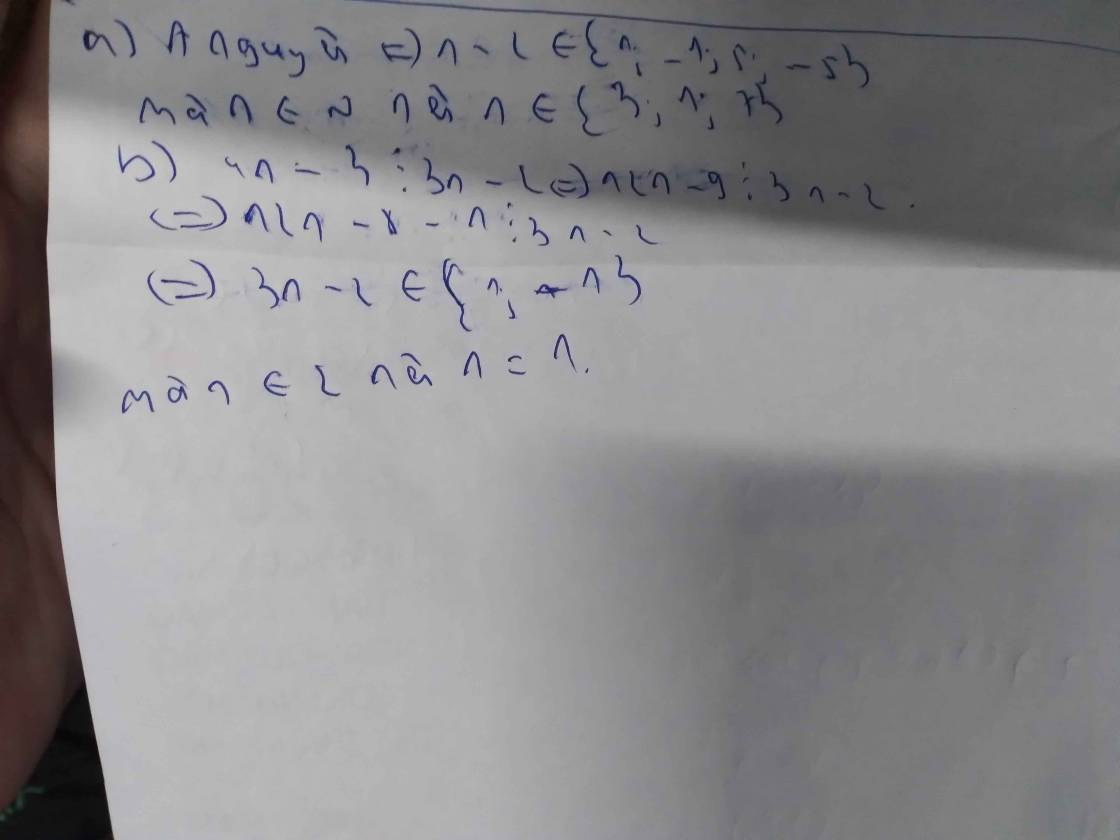
Hãy nhập câu hỏi của bạn vào đây, nếu là tài khoản VIP, bạn sẽ được ưu tiên trả lời.


Lời giải:
$B=\frac{(x+1)+1}{x+1}=1+\frac{1}{x+1}$
Để $B$ nguyên thì $\frac{1}{x+1}$ nguyên.
Với $x$ nguyên, để $\frac{1}{x+1}$ nguyên thì $1\vdots x+1$
$\Rightarrow x+1\in\left\{\pm 1\right\}$
$\Rightarrow x\in\left\{0;-2\right\}$
Với $x$ nguyên, để $\frac{5}{2x+7}$ nguyên thì:
$5\vdots 2x+7$
$\Rightarrow 2x+7\in\left\{\pm 1;\pm 5\right\}$
$\Rightarrow x\in\left\{-3;-4;-1;-6\right\}$
B=\(\dfrac{x+2}{x+1}=1\dfrac{1}{x+1}\)(x khác -1)
=> Để B nguyên thì 1 chia hết cho x+1
=> x+1 ∈Ư(1)={1,-1}
| X+1 | 1 | -1 |
| x | 0 | -2 |
Vậy để B nguyên thì x∈{0,-2}
C=\(\dfrac{5}{2x+7}\)(x khác -7/2)
Để C nguyên thì 5 chia hết cho 2x+7
=>2x+7∈Ư(5)={1,-1,5,-5}
| 2x+7 | 1 | -1 | 5 | -5 |
| x | -3 | -4 | -1 | -6 |
Để C nguyên thì x∈{-3,-4,-1,-6}

a, \(A=\dfrac{5n-4-4n+5}{n-3}=\dfrac{n+1}{n-3}=\dfrac{n-3+4}{n-3}=1+\dfrac{4}{n-3}\Rightarrow n-3\inƯ\left(4\right)=\left\{\pm1;\pm2;\pm4\right\}\)
| n-3 | 1 | -1 | 2 | -2 | 4 | -4 |
| n | 4 | 2 | 5 | 1 | 7 | -1 |
a.\(A=\dfrac{2n+1}{n-3}+\dfrac{3n-5}{n-3}-\dfrac{4n-5}{n-3}\)
\(A=\dfrac{2n+1+3n-5-4n+5}{n-3}\)
\(A=\dfrac{n+1}{n-3}\)
\(A=\dfrac{n-3}{n-3}+\dfrac{4}{n-3}\)
\(A=1+\dfrac{4}{n-3}\)
Để A nguyên thì \(\dfrac{4}{n-3}\in Z\) hay \(n-3\in U\left(4\right)=\left\{\pm1;\pm2;\pm4\right\}\)
n-3=1 --> n=4
n-3=-1 --> n=2
n-3=2 --> n=5
n-3=-2 --> n=1
n-3=4 --> n=7
n-3=-4 --> n=-1
Vậy \(n=\left\{4;2;5;7;1;-1\right\}\) thì A nhận giá trị nguyên
b.hemm bt lèm:vv

`a)A in ZZ`
`=>n+1 vdots n-3`
`=>n-3+4 vdots n-3`
`=>4 vdots n-3`
`=>n-3 in Ư(4)={+-1,+-2,+-4}`
`=>n in {2,4,5,1,-1,7}`
Vậy `n in {2,4,5,1,-1,7}` thì `A in ZZ`
b) để A là phân số thì A `cancel{in} Z`
`=>n ne {2,4,5,1,-1,7}`
Vậy `n ne {2,4,5,1,-1,7}` thì A là phân số
a)Để A là số nguyên thì n+1 ⋮ n-3
⇒n+1 ⋮ n−3
⇒n−3+4 ⋮ n−3
⇒4 ⋮ n−3
⇒n-3 ∈ Ư(4)={±1,±2,±4}
⇒n ∈ {2,4,5,1,−1,7}
Vậy n ∈ {2,4,5,1,−1,7} thì A ∈ Z
b) Để A là phân số thì A ∈ Z
⇒n ≠ {2,4,5,1,−1,7}
Vậy n ≠ {2,4,5,1,−1,7} thì A là phân số
Chúc bạn học tốt!

\(\dfrac{x-2}{x-1}=\dfrac{x-1-1}{x-1}=\dfrac{x-1}{x-1}-\dfrac{1}{x-1}=1-\dfrac{1}{x-1}\)
Để nguyên thì \(x-1\in U\left(1\right)=\left\{\pm1\right\}\)
x-1=1 => x=2
x-1=-1 => x=0

A = \(\dfrac{2x-1}{x+2}\)
a, A là phân số ⇔ \(x\) + 2 # 0 ⇒ \(x\) # -2
b, Để A là một số nguyên thì 2\(x-1\) ⋮ \(x\) + 2
⇒ 2\(x\) + 4 - 5 ⋮ \(x\) + 2
⇒ 2(\(x\) + 2) - 5 ⋮ \(x\) + 2
⇒ 5 ⋮ \(x\) + 2
⇒ \(x\) + 2 \(\in\) { -5; -1; 1; 5}
⇒ \(x\) \(\in\) { -7; -3; -1; 3}
c, A = \(\dfrac{2x-1}{x+2}\)
A = 2 - \(\dfrac{5}{x+2}\)
Với \(x\) \(\in\) Z và \(x\) < -3 ta có
\(x\) + 2 < - 3 + 2 = -1
⇒ \(\dfrac{5}{x+2}\) > \(\dfrac{5}{-1}\) = -5 ⇒ - \(\dfrac{5}{x+2}\)< 5
⇒ 2 - \(\dfrac{5}{x+2}\) < 2 + 5 = 7 ⇒ A < 7 (1)
Với \(x\) > -3; \(x\) # - 2; \(x\in\) Z ⇒ \(x\) ≥ -1 ⇒ \(x\) + 2 ≥ -1 + 2 = 1
\(\dfrac{5}{x+2}\) > 0 ⇒ - \(\dfrac{5}{x+2}\) < 0 ⇒ 2 - \(\dfrac{5}{x+2}\) < 2 (2)
Với \(x=-3\) ⇒ A = 2 - \(\dfrac{5}{-3+2}\) = 7 (3)
Kết hợp (1); (2) và(3) ta có A(max) = 7 ⇔ \(x\) = -3

Lời giải:
a. Với $x$ nguyên, để biểu thức có giá trị nguyên thì $x-1$ là ước của $2$
$\Rightarrow x-1\in\left\{1; -1; 2;-2\right\}$
$\Rightarrow x\in\left\{2; 0; 3; -1\right\}$
b.
$\frac{x-2}{x-1}=\frac{(x-1)-1}{x-1}=1-\frac{1}{x-1}$
Để biểu thức nhận giá trị nguyên thì $\frac{1}{x-1}$ nguyên
$\Rightarrow x-1$ là ước của $1$
$\Rightarrow x-1\in\left\{1; -1\right\}$
$\Rightarrow x\in\left\{2; 0\right\}$

a, Để \(\dfrac{n+1}{n-2}\) có giá trị là một số nguyên thì n + 1 ⋮ n - 2
=> (n - 2) + 3 ⋮ n - 2
Vì (n - 2) ⋮ n - 2 nên 3 ⋮ n - 2
=> n - 2 ∈ Ư(3) ∈ {-3;-1;1;3}
=> n ∈ {-1;1;3;5}
b, Để \(\dfrac{4n+5}{2n-1}\) có giá trị là một số nguyên thì 4n + 5 ⋮ 2n - 1
=> (4n - 2) + 7 ⋮ 2n - 1
=> 2(2n - 1) + 7 ⋮ 2n - 1
Vì 2(2n - 1) ⋮ 2n -1 nên 7 ⋮ 2n - 1
=> 2n - 1 ∈ Ư(7) ∈ {-7;-1;1;7}
=> n ∈ {-3;0;1;4}


6
\(B=\dfrac{x-5+3}{x-5}=1+\dfrac{3}{x-5}\)
Để B nguyên
\(3\text{ }⋮\text{ }\left(x-5\right)\)
=>\(x\in\left\{2;4;6;8\right\}\)